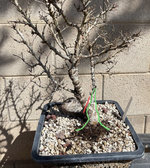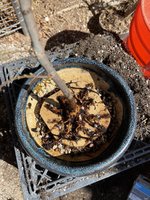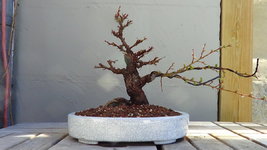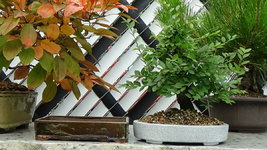Hartinez
Masterpiece
This thread is being starting for myself and others to learn more about growth management on seiju, yatsubusa and other branch clumping elms from practitioners who have experience with them.
last summer I ordered a Yatsubusa, a Seiju and a Corticosa elm from evergreen garden works. All were in exceptional health, shipped flawlessly and fairly priced. I knew and expected the habits of these elms but I’m hoping to get more insight into managing the “lumps” that form when multiple branches shoot from one location. I’ve seen exceptional examples of mature elms but am wondering what was done to combat inverse taper etc.
For instance. Here is my Yatsubusa that has multiple bulges along the lower trunk. Should I cut these back with concave cutters and apply paste? Or will the scars from healing be worse than the lumps? Do the lumps eventually blend in to the trunk once it begins to bark up?
all I did when I received this one was up pot, and I plan on sorting out the roots and flattening that ball at bud break. I’ll prob plant on a tile in an Andersen flat and let extend for the year.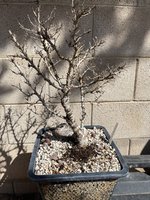
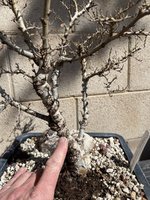
@just.wing.it youve got a cork bark. Any insight in the time you’ve had yours? Things you’ve noticed? @Shibui have you cultivated any of these down under? @Leo in N E Illinois i always love your insight.
anyways, I hope this thread can be a resource for these elms
last summer I ordered a Yatsubusa, a Seiju and a Corticosa elm from evergreen garden works. All were in exceptional health, shipped flawlessly and fairly priced. I knew and expected the habits of these elms but I’m hoping to get more insight into managing the “lumps” that form when multiple branches shoot from one location. I’ve seen exceptional examples of mature elms but am wondering what was done to combat inverse taper etc.
For instance. Here is my Yatsubusa that has multiple bulges along the lower trunk. Should I cut these back with concave cutters and apply paste? Or will the scars from healing be worse than the lumps? Do the lumps eventually blend in to the trunk once it begins to bark up?
all I did when I received this one was up pot, and I plan on sorting out the roots and flattening that ball at bud break. I’ll prob plant on a tile in an Andersen flat and let extend for the year.


@just.wing.it youve got a cork bark. Any insight in the time you’ve had yours? Things you’ve noticed? @Shibui have you cultivated any of these down under? @Leo in N E Illinois i always love your insight.
anyways, I hope this thread can be a resource for these elms

